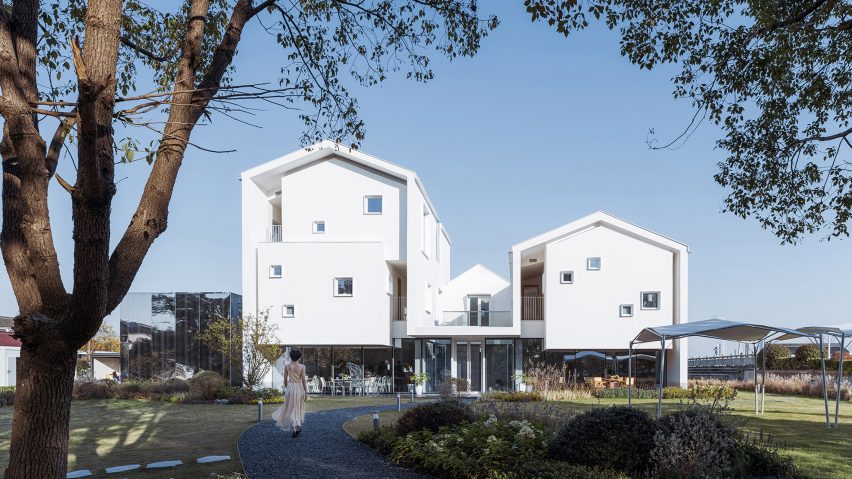Shanghai studio Wutopia Lab has completed The White Section Homestay, a guesthouse near Suzhou with rooms that appear to float within the building volume.
Located in West Lindu, a village to the south of the Chinese city, the 556-square-metre building has an unusual form designed by Wutopia Lab to reveal its internal layout.
A sliced opening traces the outline of the three-storey building, creating a visual separation between the exterior walls and roof, and the rooms contained within. To add to this effect, the building's ground floor is fully glazed.
Together, this creates the impression that first- and second-floor rooms are suspended in midair.
"I regarded the interior of the building as a cavity," said architect and studio co-founder Yu Ting.
"I defined the first floor [sic] as the void in the cavity," he continued. "For the guesthouse spaces on the upper floors, I regarded them as organs in the cavity. I treated each room as an independent volume."
The White Section Homestay contains six en-suite guest rooms, with four located on the first floor and a further two on the second floor.
It is these rooms that appear as solid, floating blocks in the facade. Meanwhile the glazed sections relate to communal lounge and dining spaces on the ground floor, and corridors upstairs.
The effect is achieved with the use of reinforced concrete cantilever beams.
"When you enter the building from the west facade, you can have a vague insight into the organisational structure of the building on this seemingly cut section," added Yu.
Planning rules stipulated that the building footprint should match the structure that previously stood on this site.
As a result, the guesthouse has a C-shaped floor plan that wraps an inner courtyard.
Folding glass doors allow the ground-floor living spaces to open up to this space. Both have a floor surface of volcanic stone, which helps to blur the boundaries between indoor and outdoor.
A staircase leading to the guest rooms is flanked by a 16-metre-long window facing an adjacent river.
This window slopes up at one end to track the ascent of the stairs, creating an unusual perforation in the building's east facade.
The guest rooms are modern in their decor, although the two on the uppermost level are painted in a shade of red that references the colour of a local rice wine that has fallen out of mainstream use.
"It is probably a stubborn expression of some things that are dying," suggested Yu.
A small building next door provides a private dining room for the restaurant and a roof terrace.
It is clad in mirrors, so as not to distract from the main building.
Wutopia Lab has completed several projects that put a contemporary spin on traditional Chinese architecture. Examples include a pavilion with a cloud-shaped centre and a museum with a facade of pleated aluminium shutters.
The White Section Homestay follows the same spirit.
Despite its unusual form, the building has a white-rendered facade and gable roof profiles that give it something in common with its more traditional neighbours.
"The renderings of this white house will make people feel [it is] a little bit unsuitable in Jiangnan, but from a bird's-eye view after completion, there is no sense of disobedience," added Yu.
Photography is by CreatAR Images.
Project credits
Architecture: Wutopia Lab
Design team: Yu Ting, Huang He, Li Ziheng, Zhuang Yinfei
Document development: Shanghai Sunyat Architecture Design
Development team: Zhu Yumei, Hu Wenxiao, Shi Jiaying, Mao Bo, Mao Yaqian, Wang Can, Yu Bing, Shen Rui.
Lighting consultant: Chloe Zhang, Wei Shiyu, Chen Xingru, Liu Xueyi
Plant consultant: Liu Yuelai, Xie Wenwan
Owner: Jingcheng Culture Tourism Development (Suzhou)

